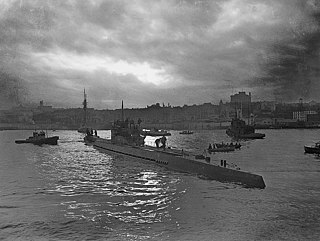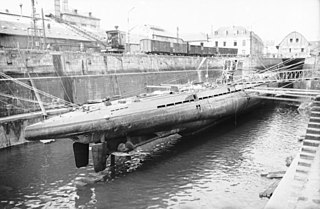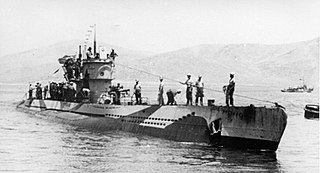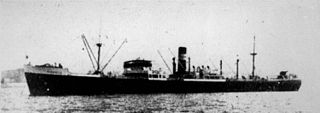Related Research Articles

German submarine U-190 was a Type IXC/40 U-boat of Nazi Germany's Kriegsmarine built for service during World War II.

A ghost ship, also known as a phantom ship, is a vessel with no living crew aboard; it may be a fictional ghostly vessel, such as the Flying Dutchman, or a physical derelict found adrift with its crew missing or dead, like the Mary Celeste. The term is sometimes used for ships that have been decommissioned but not yet scrapped, as well as drifting boats that have been found after breaking loose of their ropes and becoming carried away by the wind or the waves.

Pamir was a four-masted barque built for the German shipping company F. Laeisz. One of their famous Flying P-Liners, she was the last commercial sailing ship to round Cape Horn, in 1949. By 1957, she had been outmoded by modern bulk carriers and could not operate at a profit. Her shipping consortium's inability to finance much-needed repairs or to recruit sufficient sail-trained officers caused severe technical difficulties. On 21 September 1957, she was caught in Hurricane Carrie and sank off the Azores, with only six survivors rescued after an extensive search.

CCGS Amundsen is a Pierre Radisson-class icebreaker and Arctic research vessel operated by the Canadian Coast Guard. The vessel entered service in 1979 as Franklin and was renamed Sir John Franklin in 1980 and served as such until 1996. Declared surplus, the vessel was used as an accommodation ship in Labrador in 1996 and placed in reserve in 2000. In 2003, the ship was reactivated and underwent conversion to an Arctic research vessel. The ship recommissioned as Amundsen.
German submarine U-69 was the first Type VIIC U-boat of Nazi Germany's Kriegsmarine during World War II. This meant that compared to previous U-boats, she could travel further afield for longer, with a payload of eleven torpedoes, an 8.8 cm (3.5 in) deck gun for smaller vessels and a flak gun for use against aircraft. U-69 was very successful, sinking over 72,000 gross register tons (GRT) of Allied shipping in a career lasting two years, making her one of the longest surviving, continuously serving, U-boats. Her most notable attack was on the civilian ferry SS Caribou, which sank off the coast of Newfoundland in October 1942, killing 137 men, women and children. She was rammed and sunk by HMS Fame on 17 February 1943.
German submarine U-754 was a Type VIIC U-boat deployed by Nazi Germany's Kriegsmarine during the Second World War against allied shipping in the Atlantic Ocean. She was a successful but short-lived boat, sinking 13 ships during her career. She was most notorious for her final attack, in which she shelled and sank the small fishing vessel Ebb, and killed a number of its crew with machine-gun fire as they attempted to launch a life raft. She was sunk with all hands by a Royal Canadian Air Force bomber three days later on 31 July 1942.

MS Arctic Explorer was a ship which sank off St. Anthony, Newfoundland, in the Strait of Belle Isle, on 3 July 1981.

German submarine U-37 was a Type IXA U-boat of the German Navy (Kriegsmarine) during World War II. The submarine was laid down on 15 March 1937 at the DeSchiMAG AG Weser yard in Bremen, launched on 14 May 1938, and commissioned on 4 August 1938 under the command of Kapitänleutnant Heinrich Schuch as part of the 6th U-boat Flotilla.

German submarine U-99 was a Type VIIB U-boat of Nazi Germany's Kriegsmarine during World War II. She was laid down on 31 March 1939 at the Friedrich Krupp Germaniawerft in Kiel as yard number 593. She was launched on 12 March 1940 under the command of Korvettenkapitän Otto Kretschmer and was assigned to the 7th U-boat Flotilla based in Kiel and later in St Nazaire.

German submarine U-43 was a Type IXA U-boat of Nazi Germany's Kriegsmarine during World War II. The keel for U-43 was laid down in August 1938 at Bremen; she was launched in May 1939 and commissioned in August.

MS Nordlys is a Norwegian-registered cruise ship operated by Hurtigruten. She was built by Volkswerft GmbH in Stralsund, Germany in 1994. She has two sister ships, Kong Harald and Richard With which also sail for Hurtigruten. The ship caught fire in September 2011 while sailing off Ålesund, Norway.

German submarine U-81 was a Type VIIC U-boat of the navy (Kriegsmarine) of Nazi Germany during World War II, famous for sinking the aircraft carrier HMS Ark Royal.
SM U-66 was the lead ship of the Type U-66 submarines or U-boats for the Imperial German Navy during World War I. The submarine had been laid down in Kiel in November 1913 as U-7, the lead ship of the U-7 class for the Austro-Hungarian Navy. They became convinced after the outbreak of war in August 1914 that none of these submarines could be delivered to the Adriatic via Gibraltar, and sold the entire class, including U-7, to the German Imperial Navy in November 1914.

Danny F II was a cargo ship built in 1975 as a car carrier. She was renamed Danny F II when rebuilt as a livestock transporter in 1994. The ship capsized and sank off Lebanon on 17 December 2009, carrying 83 people, 10,224 sheep, and 17,932 cattle. 40 people were rescued and 11 found dead. The other crew, passengers and animals are presumed to have died.

SS Oceana was a P&O passenger liner and cargo vessel, launched in 1887 by Harland and Wolff of Belfast and completed in 1888. Originally assigned to carry passengers and mail between London and Australia, she was later assigned to routes between London and British India. On 16 March 1912 the ship collided in the Strait of Dover with the Pisagua, a 2,850 GRT German-registered four-masted steel-hulled barque. As a result Oceana sank off Beachy Head on the East Sussex coast, with the loss of 17 lives.

SS Hopestar was a 5,267 GRT cargo ship that was built in 1936 by Swan, Hunter and Wigham Richardson Ltd, Newcastle upon Tyne, Northumberland for the Wallsend Shipping Co Ltd. She sank off the coast of Newfoundland in 1948 with the loss of all 40 crew.
MV Stellar Daisy was a South Korean-owned very large ore carrier (VLOC) that sank on March 31, 2017 in the South Atlantic off the coast of Uruguay while on a voyage from Brazil to China. She was the largest ship, by a factor of over three on gross tonnage, to be lost at sea.
MV Monte Palomares was a Spanish cargo ship that operated from 1961 until her sinking in 1966 with the loss of 32 of her 38 crew.
MV Salvador Allende was a cargo ship that sank in December 1994 in the North Atlantic Ocean with the loss of 29 of her 31 crew members.
MV Mekhanik Tarasov was a Soviet Union-flagged cargo ship that was in service from 1976 until her sinking in 1982 in the North Atlantic Ocean.
References
- 1 2 3 4 5 6 "PROTEKTOR (6704957)" . Miramar Ship Index . Retrieved 13 September 2020.
- 1 2 3 4 "Cargo Ship Sinks Off Newfoundland". The New York Times. 13 January 1991. Retrieved 13 September 2020.
- ↑ "Search ends, ship's crew feared dead". Canadian Press. 15 January 1991. Retrieved 13 September 2020.